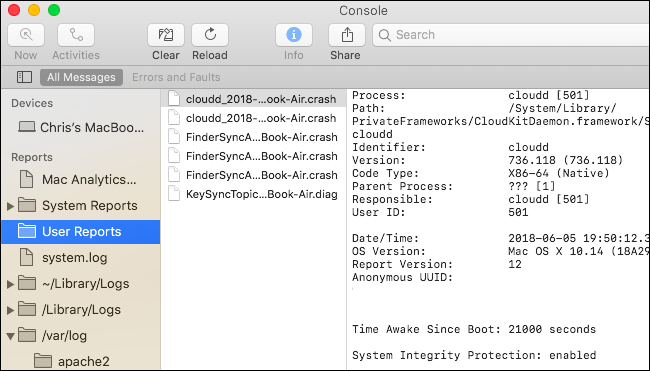

- MAC EVENT LOGS HOW TO
- MAC EVENT LOGS DOWNLOAD
- MAC EVENT LOGS MAC
MAC EVENT LOGS MAC
See the Collect and enable logging section for Windows and Mac instructions. The files will be available in %userprofile%\Downloads.

 The files will be available in ~/Downloads. Keyboard shortcut: Ctrl + Alt + Shift + 1. They can be read using any text-based editor, and new logs are created when logging into the client.ĭebug logs show the following data flows:Ĭonnection requests to middle-tier services The logs are text-based and are read from the bottom-up. Debug logs are produced by the Windows and Mac desktop clients, as well as by browser-based clients. Clientįor a complete list of supported operating systems and browsers, see Get clients for Microsoft Teams. Log files are stored in locations specific to the client and operating system. The following table outlines the various clients and their associated logs. These still function and will complete the same log capture as the Collect support files option. The debug logs were previously collecting using the keyboard shortcuts below. This URL can be captured by hovering over the join URL and choosing Copy Hyperlink. This information can be collected from any participant for a meeting or from presenter or producer for a live event. This provides additional information to help pinpoint the exact meeting or live event in the logs. If a problem occurs with a specific meeting or live event, it's helpful to have the URL associated with the meeting. After you quit, just click the app icon to open it again). The Teams client must be restarted for logging to begin (restart it by right-clicking the icon in your dock (Mac) or taskbar (Windows) and selecting Quit. Go to Settings > General, and select Enable logging for meeting diagnostics (requires restarting Teams). To enable Media logging, users must turn on the option in the Teams client. You can collect the files using the following keyboard shortcuts: The folder will contain folders for Desktop, Meeting (Media), and Debug (web). This folder can be compressed and shared when you open a support request with Microsoft Support. Select the Help menu and choose Collect support files.ĭebug, Desktop, and Media logs will be collected in one folder with the name MSTeams Diagnostics Log. Right-click on the Teams icon in the system tray and choose Collect support files. The logs can be collected together with just a couple of clicks. It’s important to collect logs as soon as an issue occurs. However, the files that are generated for these logs will contain the term diagnostic logs in their names. Now, it’s your turn to have a try.In this article, the term Debug logs refers to the logs that are used for troubleshooting.
The files will be available in ~/Downloads. Keyboard shortcut: Ctrl + Alt + Shift + 1. They can be read using any text-based editor, and new logs are created when logging into the client.ĭebug logs show the following data flows:Ĭonnection requests to middle-tier services The logs are text-based and are read from the bottom-up. Debug logs are produced by the Windows and Mac desktop clients, as well as by browser-based clients. Clientįor a complete list of supported operating systems and browsers, see Get clients for Microsoft Teams. Log files are stored in locations specific to the client and operating system. The following table outlines the various clients and their associated logs. These still function and will complete the same log capture as the Collect support files option. The debug logs were previously collecting using the keyboard shortcuts below. This URL can be captured by hovering over the join URL and choosing Copy Hyperlink. This information can be collected from any participant for a meeting or from presenter or producer for a live event. This provides additional information to help pinpoint the exact meeting or live event in the logs. If a problem occurs with a specific meeting or live event, it's helpful to have the URL associated with the meeting. After you quit, just click the app icon to open it again). The Teams client must be restarted for logging to begin (restart it by right-clicking the icon in your dock (Mac) or taskbar (Windows) and selecting Quit. Go to Settings > General, and select Enable logging for meeting diagnostics (requires restarting Teams). To enable Media logging, users must turn on the option in the Teams client. You can collect the files using the following keyboard shortcuts: The folder will contain folders for Desktop, Meeting (Media), and Debug (web). This folder can be compressed and shared when you open a support request with Microsoft Support. Select the Help menu and choose Collect support files.ĭebug, Desktop, and Media logs will be collected in one folder with the name MSTeams Diagnostics Log. Right-click on the Teams icon in the system tray and choose Collect support files. The logs can be collected together with just a couple of clicks. It’s important to collect logs as soon as an issue occurs. However, the files that are generated for these logs will contain the term diagnostic logs in their names. Now, it’s your turn to have a try.In this article, the term Debug logs refers to the logs that are used for troubleshooting. MAC EVENT LOGS HOW TO
How to clear all event logs Windows 11/10? The top 4 methods have been illustrated. Once finished, the Command Prompt window will automatically close. After that, an elevated Command Prompt will start clearing the event logs. bat file and select Run as administrator. Double click the bat file and click on Run in the pop-up window to unblock the file.
MAC EVENT LOGS DOWNLOAD
Clear here to download the Clear_Event_Viewer_Logs.bat file and save it to your desktop. You also can clear event logs in Windows 11/10 directly using a BAT file. In the elevated PowerShell window, type the following command and hit Enter to clear all event logs. Step 1. Type powershell in the search box, and then right-click Windows PowerShell from the top result and select Run as administrator. In addition to using Command Prompt, Windows PowerShell can help you clear event logs in Windows 11/10. Clear Event Logs Using Windows PowerShell Once you clear all event logs Windows 11, you can close the Command Prompt window. Step 2. In the elevated Command Prompt, type the following command and hit Enter.įor /F "tokens=*" %1 in ('wevtutil.exe el') DO wevtutil.exe cl "%1" Then click on Yes in the UAC window to confirm it. Step 1. Type cmd in the search box, and then right-click the Command Prompt from the top result and select Run as administrator. Also, you can try the following 4 methods. Here’s how to clear all event logs Windows 11. Click on Clear in the pop-up confirmation window. Expand the Windows Logs category from the left sidebar, and then right-click a log (ex: Application) and select Clear Log. Press Win + R keys to open the Run dialog box, and then type eventvwr.msc in it and hit Enter. Note: To clear all event logs in Event Viewer Windows 11/10, you must be signed in as an administrator and make sure the Windows Event Log service is enabled and running.







 0 kommentar(er)
0 kommentar(er)
